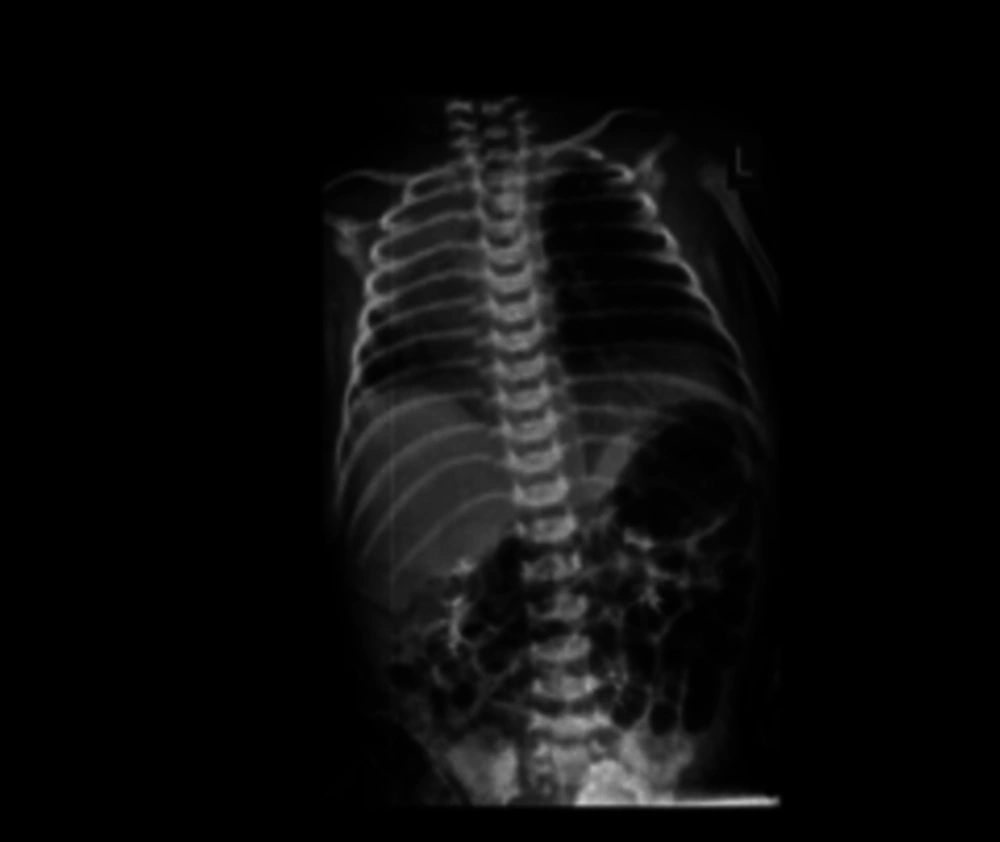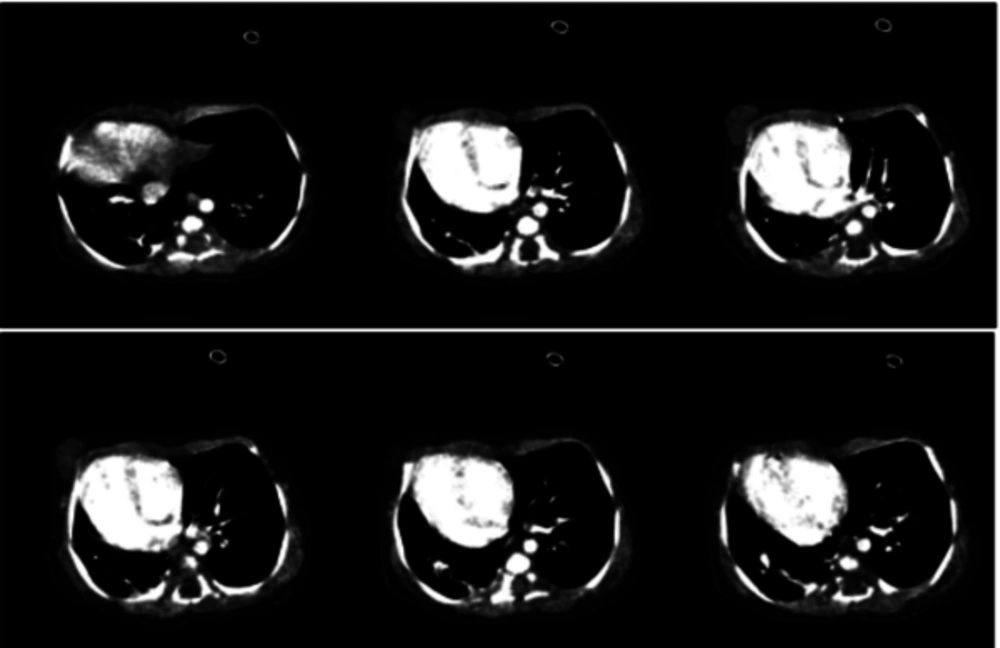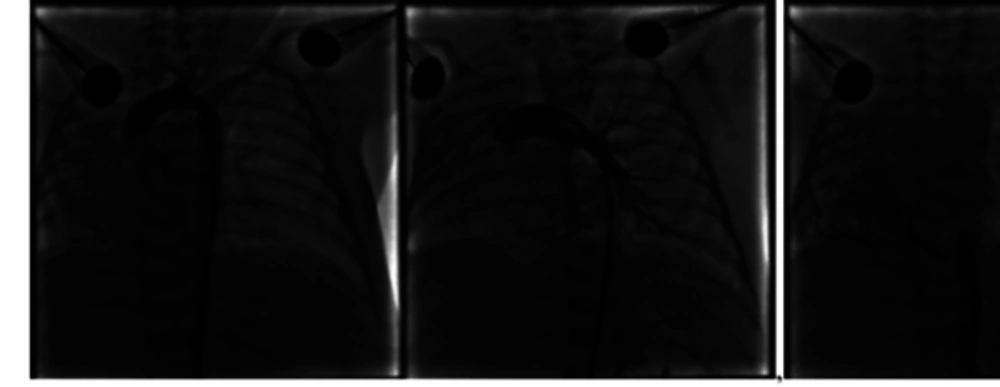1. Introduction
Scimitar syndrome is a rare and complex congenital defect that often involves hypoplasia of the right lung and partial anomalous pulmonary venous connection of the right lung draining into the inferior vena cava. The right pulmonary artery is usually hypoplastic; however, it is fully absent (1-3). Systemic collateral artery from the descending aorta supplies the right lower lobe (lobar sequestration).
The term “scimitar” was derived from the shadow created by the abnormal right lower pulmonary vein on the chest X-ray that connected to inferior vena cava resembles an arched Turkish sword (4). Up to now, several associations have been described with scimitar syndrome, including hypoplasia of the right lung, anomalies of the bronchial system, horseshoe lung, hypoplasia of the right pulmonary artery, anomalous arterial connection to the right lung from the aorta, pulmonary sequestration, and secondary dextrocardia due to lung disease (5).
2. Case Presentation
A male neonate was noted to have imperforated anus soon after birth. He was the product of normal vaginal delivery, gravid 4, live 3, and abortion 1 from a 27-year-old mother. The patient had no cardiopulmonary symptoms, but right-sided white lung and abnormal heart shadow were detected in pre-operation chest radiography (Figure 1). After the operation, he was referred to our neonatal intensive care unit for cardiopulmonary evaluation due to his imperforated anus. On physical examination, he was 3.5 kg with no cyanosis and his right hand arterial saturation was 90% at room temperature. His respiratory rate was 50/min and his respiratory pattern was normal. Nonetheless, he had a decreased breathing sound and dullness to percussion on the right hemithorax. His heart rate was 165/min and the blood pressure of his right hand was 70/45 mmHg. In addition, the pulse of extremities was present, but his lower extremities were slightly cold with weak pulse. Moreover, the heart sound was heard in the right mid-clavicular line and an ejection systolic murmur of grade 3/6 could also be heard.
Chest radiography showed white right hemithorax with right mediastinal shift. On echocardiography, the patient had coarctation of the aorta, right pulmonary artery stenosis, and right to left ductus arteriosus flow. Chest computerized tomography scan also revealed right lung hypoplasia, absence of right pulmonary artery, and drainage of the small remnant of the right lung directly into the inferior venacava (Figure 2). Besides, cardiac catheterization revealed normal filling of the main and left pulmonary arteries. Right pulmonary artery filling was absent. Furthermore, aortogram showed coarctation of the aorta in the juxtaductal area with 30 mmHg pressure gradient between the ascending and descending aorta and small patent ductus arteriosus (PDA). Sequestration of the lower lobe of the right lung with partial anomalous drainage to inferior vena cava was seen, as well (Figure 3). After all, scimitar syndrome was diagnosed considering the results of tomography and angiography.
During the hospital course, balloon angioplasty was successfully done to correct the coarctation of the aorta. Post-angioplasty, pressure gradient between the ascending and descending aorta became 10 mmHg. The patient was discharged in a good condition on the 22nd day of his birth.
3. Discussion
Partial anomalous pulmonary venous connection (PAPVC) refers to a situation where some, but not all, venous drainage enters the left atrium and the remaining veins connect to the right-sided circulation. Scimitar syndrome is a kind of PAPVC in which, an anomalous pulmonary vein descends from the right lung and drains into the inferior vena cava (6). The abnormal pulmonary vein draining into the inferior vena cava can often be seen as a classic curvilinear density on the right chest on plain radiography and forms a sort of a Turkish sword or scimitar, but this may not always be seen. Thus, this syndrome is also named congenital pulmonary veno-lobar syndrome, hypogenic lung syndrome, vena cava bronchovascular syndrome, or epibronchial right pulmonary artery syndrome (1, 3). Schramel recognized two different types of scimitar vein: 1- the simple classic vein running from the middle of the right lung to the cardiophrenic angle and 2- double arched vein in the upper and lower lung zones, with drainage into the left atrium and inferior caval vein (7). The infantile form of scimitar syndrome can be symptomatic soon after birth. The clinical course is usually presented by severe pulmonary hypertension and sign of right heart failure. Thus, its management can be accompanied with high mortality (8). Since there was no similar report of the association between imperforated anus and asymptomatic scimitar syndrome, this case report was presented.
3.1. Conclusion
This case report indicated the importance of careful and repeated examination of even asymptomatic neonates for early diagnosis of neonatal problems. Moreover, one congenital anomaly should make us really suspicious about the existence of other anomalies.


